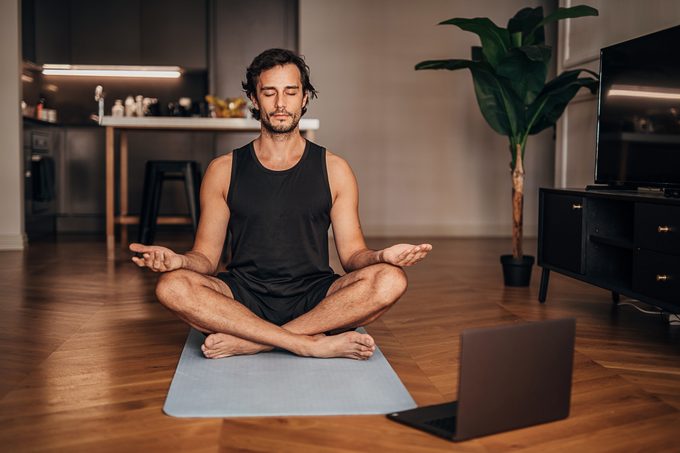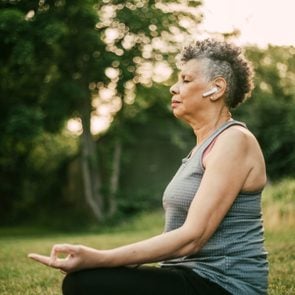8 Types of Meditation: Which Type Is Best for You?
Updated: Jun. 25, 2021
From mindfulness to movement, there are many different forms and types of meditation that can help improve your mental clarity.
The rising popularity of meditation
If Oprah has a daily meditation practice, along with Jennifer Aniston, Kendrick Lamar, and countless other celebs, it’s got to be something worth trying, right?
When you start to search for a practice, however, the sheer number and types of meditation may overwhelm you.
Take a deep breath.
“Meditation is sort of like going to the gym. Once you’re in the gym, there are a lot of different machines and exercises you can do while you’re there,” says Cory Muscara, co-host of Mindfulness.com and author of Stop Missing Your Life: The Power of Being Present.
“So meditation is a larger umbrella term for different ways to train the mind, and within that, there are lots of different approaches you can take,” he says.
And while you’re exhaling, discover how breathing can help stop pain.
So, what is meditation anyway?
One reason the topic can get complicated is that there are different traditions of meditation, many stemming from Buddhist practices. Even within Buddhism, there are different schools around the world, explains Muscara, a former monk and instructor at the University of Pennsylvania in Philadelphia.
“You also have the secular mindfulness and meditation, which is sort of divorced from those traditions. And within that, there are these different practices,” he adds.
But basically, meditation comes down to the process of training your mind to become more aware of the present moment. To do that, some techniques have you focus on the breath, others on a word or mantra.
They all have this in common: You learn how to observe your thoughts and feelings as they pop up without judging them.
If your mind wanders, you gently return your attention back to the present moment. The non-judgy part is the one many people get hung up on.
“It doesn’t mean that you’re not going to have judgments, because what ends up happening is people go, ‘I hate this,'” Muscara explains. “And then they’re like, ‘Oh my gosh. Now I’m judging, and now I’m judging myself for judging myself,’ and it just becomes this downward spiral.”
The fix?
“Replace the word non-judgment with curiosity, because a curious mind is inherently nonjudgmental. It’s not trying to create anything. It just wants to understand and know what is here, and it can take some of the pressure off,” he says.
Mindfulness meditation
Think of mindfulness meditation as the more secular version of meditation, says Muscara.
It was popularized in the 1990s by Jon Kabat-Zinn, a professor at the University of Massachusetts who’s written books and offered mindfulness meditation programs.
“Mindfulness involves being guided to making contact with the body and the breath and it’s intended to bring us into a very calm, quiet, and still state,” says Dan Globus, lead meditation and mindfulness instructor at Meditation House, in New York.
Mindfulness practices can be guided or self-directed.
“Guided is an umbrella term to just describe any of these meditations could be guided meditations—where someone walks you through it—or you direct yourself going through them,” Muscara notes.
There are many practices within mindfulness, but they can be broken down into four main types:
Focused meditation
In this type of practice, you give yourself one thing to focus on: a sound, your breath, even a mantra (though mantras aren’t widely used in mindfulness meditation).
“You could think of this as a bicep curl for your brain: The mind wanders, you bring it back, it wanders, you bring it back,” explains Muscara.
Try this practice if: Your mind is all over the place and you want to focus better, be more present in your life, and listen, says Muscara. The very fact of noticing when the mind wanders and the act of bringing it back can improve concentration, even for new meditators who have a 10-minute practice, per a 2018 study in Frontiers in Human Neuroscience.
(You can also try eating these super-foods for more focus.)
Body scan
When you do a body scan, you start at the top of your head and work your way down to your feet (or vice versa), observing each part of the body and how it feels, says Nikki Gingrich, a meditation and mindfulness coach in Allentown, Pennsylvania, and a teacher for Insight Timer, a meditation app that focuses on sleep, anxiety, and stress.
The point is not to relax each part (like a progressive relaxation, say) or change anything but simply notice where there might be stiffness, pain, or tension.
“It’s focusing your thoughts on the body rather than the thoughts in your head,” she says.
“Some people might get tingling in different joints as you pay attention to it, or feel an itch. Okay, well, just you don’t have to scratch the itch, but just notice that it’s there. You’re just an observer of saying how is this feeling and what’s happening. You’re just paying attention,” she explains.
Body scans are a good way to reconnect the brain to your body and emotions, says Muscara, who adds that doing body scan meditations develop emotional intelligence and emotional regulation.
Try this practice if: You’re somebody who lives inside your head. You also aren’t feeling any joy or feel numb to difficult emotions, says Muscara.
Open monitoring meditation
Also called open presence or choiceless awareness, the emphasis in this type of practice is less doing, and more being, Muscara explains.
“Instead of focusing on any one thing in particular—like the breath or a mantra, or even the body—you’re just looking out into the distance. You might see a bird arise, you might see a tree, there could be a gust of wind, someone might walk by. You’re just being. You’re inhabiting awareness itself and noticing what moves through that awareness,” he notes.
Try this practice if: There is a lot of stress and “doing” in your life and you need to relax and be more in the present, Muscara suggests.
(You can also try these other expert-approved stress-management tips.)
Loving-kindness meditation
In this type of meditation, you’re opening yourself up to receiving love, says Gingrich—as well as sending it out.
You can start by imagining someone (two- or four-legged) you really love and the loving phrases they might say to you.
It could be “May you be happy and safe” and “May you be healthy” and “May you be loved.” The phrases don’t really matter as much as the feelings behind them.
From there, you can send those loving phrases back to the person, or to someone who doesn’t rank high on your favorites list, or to the world, says Gingrich.
“Just promoting that energy creates a sense of calm and can really shift your perspective, which is a really beautiful place to come from,” she adds.
Try this practice if: You are in need of self-compassion, or you want to cultivate empathy, especially if you’ve gone through some trauma and pain, says Muscara.
The aim is to develop more compassion and empathy, and more of a sense of connection with others.
And this meditation may even slow the aging process, according to a 2019 study in Psychoneuroendocrinology.
Vipassana meditation
This type of meditation is known as insight meditation, and it is centuries old.
“It is bringing the mind into a very still state—so still, so clear, so calm that we gain insight into who and what we are, and ultimately to gain insight into how to bring about change,” Globus explains.
Think of this as hard-core meditation—there are 7- or 10-day Vipassana retreats where you sit for hours in silence.
Basically, you start by observing your breath, but you are supposed to work your way into a state where you’re not connecting with anything.
“We’re not connecting with the breath, the body, or the mind. It’s a very pure state. And it takes a tremendous amount of practice to get to that point,” says Globus.
Some practitioners also describe this practice as thought watching.
“You’re observing your thoughts, but you want to observe your thoughts as a third party, unattached or detached from the emotion that comes to them,” Gingrich explains.
And while this type of meditation hasn’t been studied as much as mindfulness has, studies published in the Journal of Alternative and Complementary Medicine and Scientific Reports say it boosts gray matter in your brain and Canadian researchers find that experienced practitioners were less emotionally reactive.
Try this practice if: You’re an experienced meditator and want to go on a spiritual journey.
(Here’s what to know about RAIN meditation and if you should try it.)

Transcendental meditation
Transcendental meditation has been around since the 1960s—popularized when the Beatles went to India to study with the Maharishi Mahesh Yogi. Jerry Seinfeld and Hugh Jackman are devotees.
You learn transcendental meditation by going to four classes, about an hour each, based on a sliding fee according to your income (but expect to spend anywhere from roughly $400 to nearly $1,000).
“Transcendental meditation is based upon mantra—one or more words that it supposed to be unique to each and every person,” Globus explains.
“The mantra is given to you by your teacher—you’re never supposed to share it with anyone or mention it to anyone.”
You repeat this mantra for about 15 to 20 minutes, twice a day.
The beauty of transcendental meditation is that it’s simple—it gives your mind something to hold onto when it wanders. It can also be effective for calming your mind and your body, says Globus.
Try this practice if: You’ve tried other forms of meditation and felt that they were tough to get into or you’re looking for a new way to meditate and don’t mind spending a little money.
(Here are the meditation quotes to help you stay grounded.)
Visualization meditation
This type of practice is like going on a journey: “You bring someone to their favorite place—the beach or the mountains or somewhere serene—where they can relax,” says Gingrich, who’s done this type of meditation for clients.
If you’re at the beach, you’ll picture yourself listening to the waves, feeling the sun on your body, and smelling the air.
The aim is to get out of your current mood by picturing a place that brings you peace and relaxation. “And if you go to a place that brings you that calm and ease and sense of being grounded, you’re going to feel that within your body,” notes Gingrich.
Another type of visualization practice involves picturing a particular goal or dream you have. If you want a new job, say, you’d visualize yourself going to that job—seeing who your colleagues are, what you’d wear, what the workplace would look like, Gingrich explains.
Or you can picture someone in your mind, as you do in a loving-kindness meditation.
Try this practice if: You’re a person who thinks in images or you want to make a dream into a reality.
(Here are 10 ways to sneak meditation into your daily life.)
Movement meditation
This is exactly what it sounds like—doing something physically active while being mindful. Maybe the easiest way is a walking meditation.
“Often we get lost in our thoughts, and we start thinking about our to-do list or our problems,” says Gingrich. “But if you go on a walk and observe the things around you—the houses, the grass, the trees, or whatever it is that you’re walking past—you’re consciously being aware of it. And that will bring you into the present moment.”
You can also focus on your breath or footsteps. Walking meditations can be mood boosters, according to a 2018 study in Psychology of Sport and Exercise.
There are other forms of meditative movement, like yoga, tai chi, and qigong, which is a Chinese mind-body exercise that involves breathing as you hold different postures.
Another study in Frontiers in Psychology reviewed the evidence and found that these meditative movement practices reduce anxiety and depression.
Try this practice if: “You’re you’re starting with meditation, and you’re a little scared of it or you don’t want to sit still,” says Gingrich. “These are really beautiful ways to introduce meditation and breathing and mindfulness into your life because they give you something to do.”
(Learn more about practicing meditation for depression.)
How to find the right meditation practice
“For someone starting out, it’s helpful to view it as a bit of a buffet,” says Muscara.
“You download a meditation app and there’s a lot there, and you might take a course within that app and you’ll be exposed to different techniques. At this stage, it’s more just about taking some time to get acquainted with your mind.”
In fact, just about all meditation apps will offer courses built around a theme that go for as few as 7 days and as long as 30. Taking a course can introduce you to different practices until you hit upon one that resonates, say meditation teachers.
“I don’t know if there’s one way to say how you’re going to know because everybody’s an individual, but I would say you would know,” Gingrich notes.
“It’s really a cool feeling as a teacher when a client says, ‘I’ve been meditating and I feel really good’ and you’re like, ‘Okay, you’re onto something. Keep going, keep going, keep going.'”
When that happens, try these five ways to make meditation a daily habit, no matter which type you do.
Next, check out these meditation pillows or other meditation tools to help you in your practice.
















